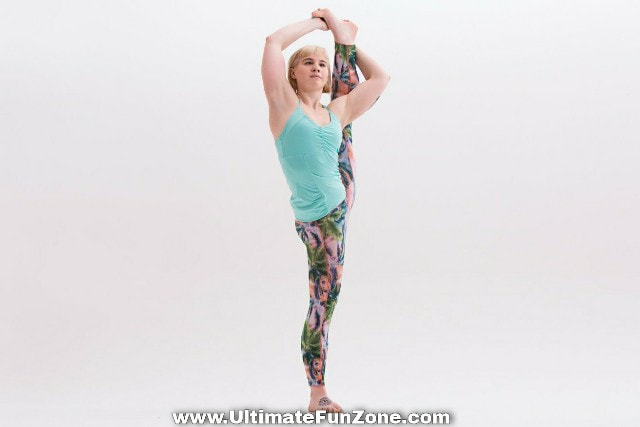Yoga Pose:
Utthita Trivikramasana
Important Note
Take special precautions while doing any asana. If you are learning yoga, then take the advice of a knowledgeable person. Do not put any kind of force in the event of pain or unable to do so. Keep in mind that you will be able to succeed only with constant practice.
Brief Introduction Of The Utthita Trivikramasana
- It is also referred to as the Split Pose. Doing this pose regularly balances and benefits the whole body. This asana is of two types, namely Supta and Utthita Trivikramasana. This is a difficult yoga that can be mastered with practice. It energies your body, strengthens your muscles as well as balances the mind. Supta in the Sanskrit language means resting, while Trivikram means 3 steps and asana stands for pose or posture. Rather, termed as a variation of the nose to the leg. The hamstring muscle gets stretched in this particular pose. Very little difference exists between both Supta and Uttitha Trivikramasana.
- Uttitha means Standing Splits pose. This asana is done in the standing position. This asana is good enough to stretch your body parts that do not get stretched generally. This beginners pose helps to strengthen as well as contour your body. It should be done for about 15-30 seconds and on time on each side. A few preparatory poses to do before you do this asana are:
- Supta Baddha Konasana
- Adho Mukha Svanasana
- Prasarita Padottanasana
- Supta Virasana
- Siddhasana
- Supta Padangusthasana
- Utthita Trikonasana
- Upavistha Konasana
- Virasana
- Virabhadrasana II
Supta means Supine Splits pose. It is performed by lying down on the ground or a yoga mat as desired. It is considered to be Supta Padangusthasanas advanced variation. It forms part of the third series in Ashtanga as well as that of Iyengar Yoga. It helps to open deeply the hamstrings including the gluteus maximus muscles. This asana tends to focus more on strengthening the quadriceps. Some of the preparatory poses that you can do include the following:
- Standing head to knee pose (Dandayamana Janu Sirsasana)
- Standing Cradle pose
- Supta Padangusthasana (Reclined bit toe pose with variation nose to leg)
- Supta Padangusthasana (Reclined big to pose)
How To Do The Utthita Trivikramasana?
- Stand on the mat in a position to face its longer side. Feet should be kept at a distance and heels to be in sync with one another.
- Turn your right foot out in a manner that your toes point towards the mats short edge. Left toes to be kept at a 45-degree angle.
- Exhale deeply and bend your right knee. Your thigh should be parallel to the ground.
- Your knee should be kept in line with your initial two toes and above the ankle. Ground your big toe base towards the floor. Roll out your thigh towards little toes.
- Inhale and firm up your lower belly region to suck it in. Then pull up.
- Now exhale. Then stretch body over your right leg. Bring down your right arm. Either place your hand on the ground or elbow on right thigh.
- Stretch your left arm pointing towards the ceiling to make your palm to face the front. Then roll your external upper left arm towards your face. Reach overhead and bring your arm close to your left ear.
- Take your left foot and press the external part on the floor. Roll your buttocks right side slightly under.
- Stretch your neck and spine and make your neck to be in line with your spine. Move your gaze towards your left arm.
- Move ribcage to face the ceiling. Press feet firmly while maintaining a stable foundation. Make your spine light and face soft.
- Hold on to this pose for some time. Then inhale and release the hold to get into Tadasana pose.
- Now, relax for a couple of seconds. Do the other procedure following the above steps.
Benefits Of The Utthita Trivikramasana
- It stretches your legs, ankles, knees, shoulders, lungs, waist, spine, chest and groins region.
- It increases your stamina level and stimulates your abdominal organs.
- It offers therapeutic relief from infertility, constipation, menstrual discomfort, sciatica, osteoporosis and lower backaches.
Precautions To Be Taken While Doing The Utthita Trivikramasana
- Avoid doing this asana if you suffer from insomnia, low or high blood pressure and headache.
- Avoid looking at your stretched arm if experiencing a neck problem. Instead look down or straight.
Conclusion
- The pose derives its name from Trivikrama taken from Hindu mythology.
- The pose is an ancient one that is witnessed in the statues belonging to the 13th to 18th century showcasing Bharatnatyam dance.
- Doing this asana provides your body with flexibility while strengthening your muscles.
Share This Page On...
